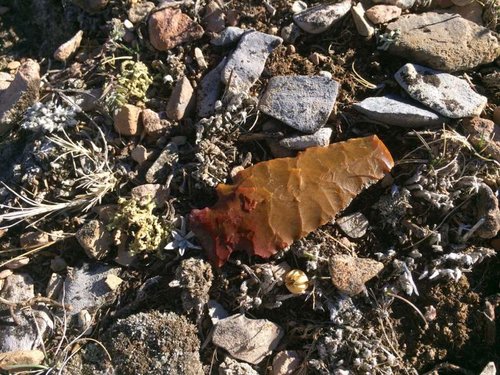Paul in Idaho
Well-known member
While searching for blood after shooting at an elk, a dark red spot on the ground caught my eye. It wasn't blood, but rather a stone projectile point. About 2.5" long, it was in excellent condition except the broken tip.

I sat down by it for a while and thought about that small connection to a fellow hunter at some unknown time in the distant past. Was the tip broken off in an elk or bison bone? Did he and his family or tribe eat well that day, or go hungry? No doubt the outcome of his hunting had far greater impact on their lives than my efforts do for my family. I had a warm and dry camp just down the mountain. What comfort did he have to return to after the hunt?
After the hunt I sent this photo to BLM, along with its GPS location, and received a great reply from an archaeologist there. Here are some excerpts:
So this stone point has likely been laying up there for at least 1,200 years. The edges were still fairly sharp despite the harsh weather on that mountain. I placed it back exactly as I had found it, and walked on, thinking about the skill it would take to get close and place a lethal hit, and cursing myself even more for having missed an easy shot with a modern rifle and optics.

I sat down by it for a while and thought about that small connection to a fellow hunter at some unknown time in the distant past. Was the tip broken off in an elk or bison bone? Did he and his family or tribe eat well that day, or go hungry? No doubt the outcome of his hunting had far greater impact on their lives than my efforts do for my family. I had a warm and dry camp just down the mountain. What comfort did he have to return to after the hunt?
After the hunt I sent this photo to BLM, along with its GPS location, and received a great reply from an archaeologist there. Here are some excerpts:
That point you found is a large dart point. It once fit onto a probable foreshaft of a roughly 4-foot long composite weapon (foreshaft, mainshaft, and often fletching) that was thrown with great force and respectable accuracy by use of an atlatl ("throwing board"). It likely predates the bow and arrow. The artifact reveals a corner-notched morphology that fits nicely into the Late Archaic "Elko Corner-Notched" sequence of projectile point styles typical in the Northern Intermountain West. ... The Elko series in this region falls within a time-frame dating from approximately 3,300 B.P. to about 1,200 B.P. ("B.P." meaning "Before Present") -- about 1,300 B.C to about A.D. 800.
So this stone point has likely been laying up there for at least 1,200 years. The edges were still fairly sharp despite the harsh weather on that mountain. I placed it back exactly as I had found it, and walked on, thinking about the skill it would take to get close and place a lethal hit, and cursing myself even more for having missed an easy shot with a modern rifle and optics.
Last edited:




